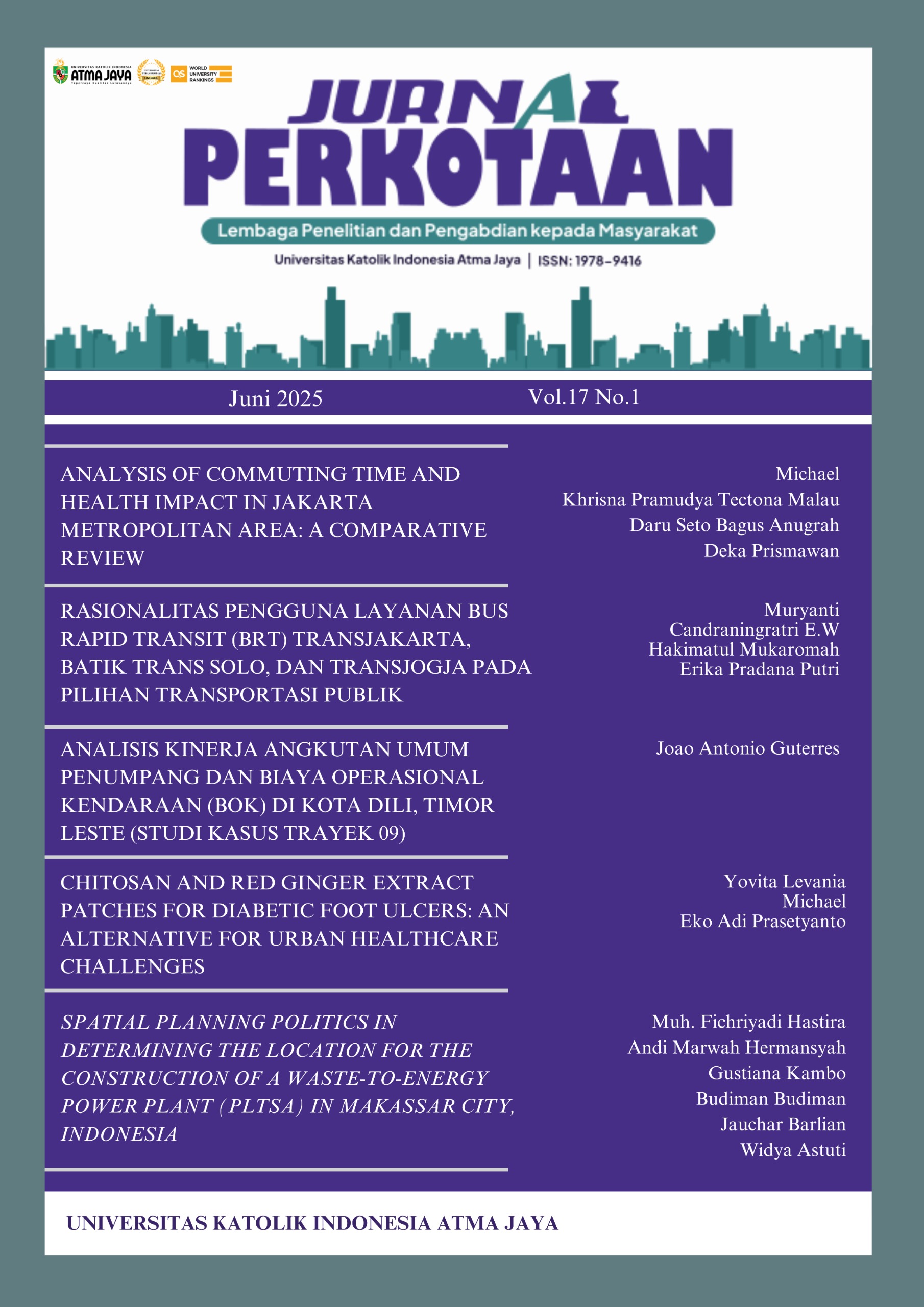Spatial Planning Politics in Determining the Location for the Construction of a Waste-To-Energy Power Plant (PLTSa) in Makassar City, Indonesia
DOI:
https://doi.org/10.25170/perkotaan.v17i1.6692Keywords:
Spatial planning politics, waste-to-energy power plant, conflict of interest, spatial justiceAbstract
This research analyzes the political dynamics in determining the location for the construction of a Waste-to-Energy Power Plant (PLTSa) in Makassar City. Although existing regulations, such as Makassar Mayor Regulation No. 1 of 2021 and Makassar City Regional Regulation No. 4 of 2015, have designated the Tamangapa Landfill as the construction site, the city government instead proposed an alternative location in the Tamalanrea District. This has sparked controversy among the community, the Regional People's Representative Council (DPRD), and business actors, as well as causing conflicts of interest among various stakeholders. With a descriptive qualitative approach, this research reveals that spatial planning decisions are not only influenced by technical and environmental aspects but also by political and economic considerations. The shifting of development locations reflects the contestation of power in urban spatial governance, where the interests of political elites and investors are often prioritized over the aspirations of the community. This research highlights the importance of transparency and public participation in spatial planning to avoid social conflicts and ensure spatial justice in infrastructure development policies.
References
[1] S. N. Qodriyatun, “Pembangkit Listrik Tenaga Sampah: Antara Permasalahan Lingkungan dan Percepatan Pembangunan Energi Terbarukan,” Aspir. J. Masal. Sos., vol. 12, no. 1, pp. 63–84, Jun. 2021, doi: 10.46807/aspirasi.v12i1.2093.
[2] P. R. Indonesia, Peraturan Presiden (Perpres) Nomor 35 Tahun 2018 tentang Percepatan Pembangunan Instalasi Pengolah Sampah Menjadi Energi Listrik Berbasis Teknologi Ramah Lingkungan. 2018. [Online]. Available: https://peraturan.bpk.go.id/Details/73958/perpres-no-35-tahun-2018
[3] SIPSN, “Capaian Kinerja Pengelolaan Sampah,” Kementerian Lingkungan Hidup/Badan Pengendalian Lingkungan Hidup Deputi Bidang Pengelolaan Sampah, Limbah dan B3 Direktorat Penanganan Sampah. Accessed: Feb. 25, 2025. [Online]. Available: https://sipsn.menlhk.go.id/sipsn/
[4] Admin, “Proyek PSEL, Solusi Persampahan di Kota Makassar,” Berandasulsel.com. Accessed: Feb. 25, 2025. [Online]. Available: https://berandasulsel.com/proyek-psel-solusi-persampahan-di-kota-makassar/
[5] W. Makassar, Peraturan Walikota Makassar Nomor 1 Tahun 2021 Tentang Pemilihan Mitira Kerjasama Pengolah Sampah Untuk Energi Listrik Berbasis Teknologi Ramah Llngkungan. 2021. [Online]. Available: https://jdih.makassarkota.go.id/dokumen/detail/peraturan-walikota-1-2021
[6] A. N. Syahidallah, “Walkot Makassar Danny Pomanto Jelaskan Soal Lokasi Proyek PSEL di Tamalanrea,” detiksulsel. Accessed: Feb. 25, 2025. [Online]. Available: https://www.detik.com/sulsel/berita/d-6877875/walkot-makassar-danny-pomanto-jelaskan-soal-lokasi-proyek-psel-di-tamalanrea
[7] A. N. Syahidallah, “Warga Ancam Tutup TPA Antang Makassar Buntut Polemik Lokasi Proyek PSEL,” detiksulsel. Accessed: Feb. 25, 2025. [Online]. Available: https://www.detik.com/sulsel/berita/d-6874112/warga-ancam-tutup-tpa-antang-makassar-buntut-polemik-lokasi-proyek-psel
[8] A. N. Syahidallah, “Warga Demo Tutup TPA Antang, Legislator Makassar Ikut Suarakan Aspirasi Massa,” detiksulsel. Accessed: Feb. 25, 2025. [Online]. Available: https://www.detik.com/sulsel/berita/d-6874840/warga-demo-tutup-tpa-antang-legislator-makassar-ikut-suarakan-aspirasi-massa
[9] R. Robet, “Ruang Sebagai Produksi Sosial Dalam Henri Lefebvre,” Cak Tarno Inst., no. 1859, p. 1, 2014, [Online]. Available: https://caktarno.wordpress.com/2014/09/06/ruang-sebagai-produksi-sosial-dalam-henri-lefebvre/
[10] S. Banerjee-Guha, “Contemporary globalisation and the politics of space,” Econ. Polit. Wkly., vol. 46, no. 52, pp. 41–44, 2011.
[11] S. Aminah, “Konflik dan Kontestasi Penataan Ruang Kota Surabaya,” Masy. J. Sosiol., vol. 20, pp. 59–79, 2015.
[12] M. Amoah, R. S. Wireko-Gyebi, S. A. Takyi, O. Amponsah, and M. Poku- Boansi, “Beyond just politics and space: A literature review,” Soc. Sci. Humanit. Open, vol. 8, no. 1, 2023, doi: 10.1016/j.ssaho.2023.100677.
[13] H. Lefebvre, The Production of Space, Translated. United Kingdom: Blackwell Publishers, 1991.
[14] E. W. Soja, “The socio-spatial dialectic,” Ann. Assoc. Am. Geogr., vol. 70, no. 2, pp. 207–225, 1980.
[15] D. Permana, “Spatial Planning Policy in the Control Aspect of Urban Area Development,” Int. J. Sci. Soc., vol. 5, no. 2, pp. 466–477, 2023, doi: 10.54783/ijsoc.v5i2.1089.
[16] D. Harvey, “Social Justice, Postmodernism and the City,” Int. J. Urban Reg. Res., vol. 16, no. 4, pp. 588–601, 1992, doi: 10.1111/j.1468-2427.1992.tb00198.x.
[17] H. Mattila, E. Purkarthofer, and A. Humer, “Governing ‘places that don’t matter’: agonistic spatial planning practices in Finnish peripheral regions,” Territ. Polit. Gov., vol. 11, no. 4, pp. 813–832, May 2023, doi: 10.1080/21622671.2020.1857824.
[18] D. Stead, “Conceptualizing the Policy Tools of Spatial Planning,” J. Plan. Lit., vol. 36, no. 3, pp. 297–311, 2021, doi: 10.1177/0885412221992283.
[19] M. Tewdwr-Jones, Collaborative planning: Shaping places in fragmented societies, vol. 14, no. 2. 1998. doi: 10.1016/s0743-0167(97)00052-1.
[20] Kemenkeu, Kerja Sama Pemerintah dengan Badan Usaha (KPBU). 2022. [Online]. Available: https://kpbu.kemenkeu.go.id/read/46-6/pjpk/tentang-kpbu
[21] R. J. Dean, “Counter-Governance: Citizen Participation Beyond Collaboration,” Polit. Gov., vol. 6, no. 1, pp. 180–188, Apr. 2018, doi: 10.17645/pag.v6i1.1221.
[22] N. Brenner and N. Theodore, “Cities and the Geographies of ‘Actually Existing Neoliberalism,’” Antipode, vol. 34, no. 3, pp. 349–379, Jul. 2002, doi: 10.1111/1467-8330.00246.
[23] E. Setiajatnika, T. Gunadi, and H. Nugraha, “Skema Kerjasama Pemerintah Dengan Badan Usaha (KPBU) Dalam Penyediaan Infrastruktur Alat Penerangan Jalan (APJ),” Coopetition J. Ilm. Manaj., vol. 14, no. 2, pp. 317–332, Jun. 2023, doi: 10.32670/coopetition.v14i2.3371.
[24] H. N. S. Tangkilisan, Manajemen Publik. Jakarta: Grasindo, 2005.
[25] P Schroder, Strategi Politik (terj.). Jakarta: Friedrich Naumann Stiftung, 2004.
[26] N. Putri, A. B. Broto, H. Purwanto, and R. Muhammad Iqbal, “Implementasi Metode Project Development Routemap pada Proyek KPBU Di Indonesia,” J. Infrastruct. Policy Manag., vol. 5, no. 1, pp. 1–14, Dec. 2022, doi: 10.35166/jipm.501.0020.
[27] Z. M. Nurtias and others, “Kerjasama Investasi Antara Pemerintah Dengan Badan Usaha,” J. Intelek Dan Cendikiawan Nusant., vol. 1, no. 2, pp. 1653–1659, 2024.
[28] K. Olesen and T. Richardson, “The Spatial Politics of Spatial Representation: Relationality as a Medium for Depoliticization?,” Int. Plan. Stud., vol. 16, no. 4, pp. 355–375, Nov. 2011, doi: 10.1080/13563475.2011.615549.
[29] J. Costa-I-Font, E. Rodriguez-Oreggia, and D. Lunapla, “Political competition and pork-barrel politics in the allocation of public investment in Mexico,” Public Choice, vol. 116, no. 1–2, pp. 185–204, 2003, doi: 10.1023/A:1024263208736.
[30] P. Marcuse, “Spatial justice: Derivative but Causal of Social Justice,” Justice injustices Spat., pp. 76–92, 2016, doi: 10.4000/books.pupo.420.
[31] G. H. Pirie, “On spatial justice.,” Environ. Plan. A, vol. 15, no. 4, pp. 465–473, 1983, doi: 10.1068/a150465.
[32] V. Nadin, D. Stead, M. Dąbrowski, and A. M. Fernandez-Maldonado, “Integrated, adaptive and participatory spatial planning: trends across Europe,” Reg. Stud., vol. 55, no. 5, pp. 791–803, May 2021, doi: 10.1080/00343404.2020.1817363.
[33] M. Reimer, P. Getimis, and H. H. Blotevogel, “Spatial planning systems and practices in Europe: A comparative perspective on continuity and changes,” Spat. Plan. Syst. Pract. Eur. A Comp. Perspect. Contin. Chang., pp. 1–311, 2014, doi: 10.4324/9781315852577.
[34] Ubaidillah, “Warga Tamalanrea Makassar Kembali Tolak Proyek PSEL di Green Eterno,” infokini.id. Accessed: Feb. 25, 2025. [Online]. Available: https://infokini.id/2024/06/03/warga-tamalanrea-makassar-kembali-tolak-proyek-psel-di-green-eterno/
[35] Y. Liu and Y. Zhou, “Territory spatial planning and national governance system in China,” Land use policy, vol. 102, p. 105288, Mar. 2021, doi: 10.1016/j.landusepol.2021.105288.
[36] M. B. Lane, “Public Participation in Planning: an intellectual history,” Aust. Geogr., vol. 36, no. 3, pp. 283–299, Nov. 2005, doi: 10.1080/00049180500325694.
[37] T. Webler, Seth Tuler, “Voices from the Forest: What Participants Expect of a Public Participation Process,” Soc. Nat. Resour., vol. 12, no. 5, pp. 437–453, Jun. 1999, doi: 10.1080/089419299279524.
[38] T. Pickering and J. Minnery, “Scale and Public Participation: Issues in Metropolitan Regional Planning,” Plan. Pract. Res., vol. 27, no. 2, pp. 249–262, Apr. 2012, doi: 10.1080/02697459.2012.661670.
[39] P. Drum, “Aristotle’s Definition of Place and of Matter,” Open J. Philos., vol. 01, no. 01, pp. 35–36, 2011, doi: 10.4236/ojpp.2011.11006.
[40] G. Gorham, “Descartes on the Infinity of Space vs. Time,” in Infinity in Early Modern Philosophy, USA: Springer, 2018, pp. 45–61. doi: 10.1007/978-3-319-94556-9_4.
[41] W. H. Rosar, “The Dimensionality of Visual Space,” Topoi, vol. 35, no. 2, pp. 531–570, 2016, doi: 10.1007/s11245-016-9385-0.
[42] A. Getis and M. Gottdiener, “The Social Production of Urban Space,” Geogr. Rev., vol. 77, no. 2, p. 232, Apr. 1987, doi: 10.2307/214983.
[43] M. Purcell, “Theorising democratic space with and beyond Henri Lefebvre,” Urban Stud., vol. 59, no. 15, pp. 3041–3059, Nov. 2022, doi: 10.1177/00420980211067915.
[44] K. van Marle, “Henri Lefebvre. Spatial politics, everyday life and the right to the city,” Griffith Law Rev., vol. 24, no. 2, pp. 335–338, 2015, doi: 10.1080/10383441.2015.1064302.
[45] L. Lamers, “Understanding how ontological conflicts materialize through dialogue between political ontology and Henri Lefebvre’s spatial theories,” Alternautas, vol. 11, no. 1, Jul. 2024, doi: 10.31273/an.v11i1.1467.
[46] E. Berisha, G. Cotella, U. Janin Rivolin, and A. Solly, “Spatial governance and planning systems in the public control of spatial development: a European typology,” Eur. Plan. Stud., vol. 29, no. 1, pp. 181–200, Jan. 2021, doi: 10.1080/09654313.2020.1726295.
[47] M. Dąbrowski and K. Piskorek, “The development of strategic spatial planning in Central and Eastern Europe: between path dependence, European influence, and domestic politics,” Plan. Perspect., vol. 33, no. 4, pp. 571–589, Oct. 2018, doi: 10.1080/02665433.2018.1513373.
[48] E. H. Stokoe and J. Wallwork, “Space invaders: The moral‐spatial order in neighbour dispute discourse,” Br. J. Soc. Psychol., vol. 42, no. 4, pp. 551–569, Dec. 2003, doi: 10.1348/014466603322595275.
[49] W. Magnusson, “Politics of urbanism: Seeing like a city,” Polit. Urban. Seeing Like a City, pp. 1–190, 2013, doi: 10.4324/9780203808894.
[50] C. Hunsberger and R. Kløcker Larsen, “The spatial politics of energy conflicts: How competing constructions of scale shape pipeline and shale gas struggles in Canada,” Energy Res. Soc. Sci., vol. 77, 2021, doi: 10.1016/j.erss.2021.102100.
[51] A. Gilbert, “The urban revolution,” Lat. Am. Transform. Glob. Mod. Second Ed., pp. 93–116, 2014, doi: 10.4324/9781315879895-13.
[52] E. W. Soja, Seeking Spatial Justice. Minnesota: University of Minnesota Press, 2013.
[53] A. Philippopoulos-Mihalopoulos, “Spatial justice: Body, lawscape, atmosphere,” Spat. Justice Body, Lawscape, Atmos., pp. 1–265, 2015.
[54] C. Legacy, “Transforming transport planning in the postpolitical era,” Urban Stud., vol. 53, no. 14, pp. 3108–3124, 2016, doi: 10.1177/0042098015602649.
[55] J. Rawls, A Theory of Justice. Cambridge University Press, 1999. doi: 10.5840/tpm20136171.
[56] J. Pløger, “Conflict, consent, dissensus: The unfinished as challenge to politics and planning,” Environ. Plan. C Polit. Sp., vol. 39, no. 6, pp. 1294–1309, 2021, doi: 10.1177/2399654420985849.
[57] K. Lalloo, “Citizenship and place: Spatial definitions of oppression and agency in South Africa,” Afr. Today, vol. 45, no. 3–4, pp. 439–460, 1998.
[58] N. Bobic and F. Haghighi, “Spatialization of oppression,” in The Routledge Handbook of Architecture, Urban Space and Politics, Volume I, New York: Routledge, 2022, pp. 3–26. doi: 10.4324/9781003112464-2.
[59] M. Dikeç, “Justice and the spatial imagination,” Environ. Plan. A, vol. 33, no. 10, pp. 1785–1805, 2001, doi: 10.1068/a3467.
[60] J. Uitermark and W. Nicholls, “Planning for social justice: Strategies, dilemmas, tradeoffs,” Plan. Theory, vol. 16, no. 1, pp. 32–50, 2017, doi: 10.1177/1473095215599027.
[61] Mark Purcel, “Urban Democracy and the Local Trap,” Urban Stud., vol. 43, no. 11, pp. 1921–1941, 2006.
[62] A. Lauren, “Differential Spaces, Power Hierarchy and Collaborative Planning : A Critique of the Role of Temporary Uses in Shaping and Making Places,” Urban Stud., vol. 50, no. 4, p. 759, 2013, [Online]. Available: http://mendeley.csuc.cat/fitxers/6cde3e1f8fb70550af00c4a2734f7920
[63] D. Harvey, Social Justice and the City. Oxford: Blackwell Publishers, 1973. doi: 10.4324/9780429451614.










